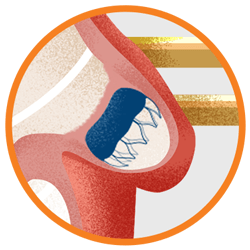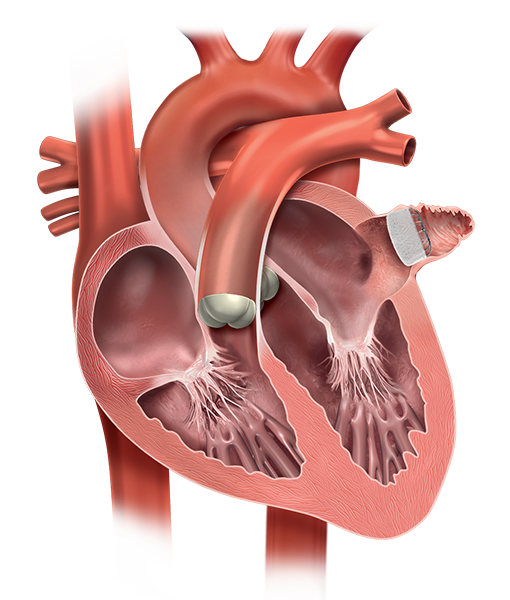
Beyond Blood Thinners
A one-time procedure that may reduce stroke risk for a lifetime.
"The blood thinner he was on was contributing to his excessive internal bleeding"
Pat, wife of Billy Stacy, WATCHMAN recipient
Oral anticoagulants
The most common treatment for managing AF-related stroke risk is the use of anticoagulants, such as vitamin K antagonist (VKA) and novel oral anticoagulants (NOACs).
Warfarin and NOACs effectively reduce the risk of cardioembolic stroke, however they are not well tolerated by some patients and carry a risk for bleeding complications.
The limitations of oral anticoagulants include:
- Risk of bleeding
- High rate of discontinuation (at 2 years, 50% of patients on warfarin and 30% on NOAC treatment)2
- Interactions with certain foods and medications (warfarin)
- Frequent blood tests and dose adjustement (warfarin)

WATCHMAN FLX closes off the left atrial appendage to reduce the risk of stroke
The WATCHMAN FLX Difference
In a one-time procedure, WATCHMAN FLX reduces the risk of stroke without the risk of bleeding that comes with long-term oral anticoagulants use.8,11
WATCHMAN FLX is for people with atrial fibrillation not caused by a heart valve problem who need an alternative to oral anticoagulants. This website is intended to provide patients and caregivers with some information about the WATCHMAN FLX Implant. It may help prepare you for talking to your doctor about your options for reducing stroke risk.
CAUTION: The law restricts these devices to sale by or on the order of a physician. Indications, contraindications, warnings and instructions for use can be found in the product labeling supplied with each device. Information for the use only in countries with applicable health authority product registrations.
Content of this website is for Information Purposes only and not meant for product promotion or medical diagnostic. This information does not constitute medical or legal advice, and BSC makes no representation or warranty regarding this information or its completeness, accuracy or timeliness.
Accordingly, BSC strongly recommends that you consult with your physician on all matters pertaining to your health or to address any questions.
References
- National Stroke Association. Making the Afib-Stroke Connection. https://www.stroke.org/sites/default/files/resources/Afib-Connection%20for%20hcp.pdf. Published 2012. Accessed September 1, 2016.
- Martinez et al. Thromb Haemost 2015;114: In press.
- American Stroke Association website. http://www.strokeassociation.org/STROKEORG/. American Heart Association. Published 2017. Accessed May 31, 2017.
- Tzikas A, et al. EuroIntervention. 2016 May 17;12(1):103-11.
- Cleveland Clinic. Atrial fibrillation (Afib). http://my.clevelandclinic.org/services/heart/disorders/arrhythmia/atrial-fibrillation-afib. Published May 2015. Accessed August 25, 2016.
- Blackshear JL, Odell JA. Appendage obliteration to reduce stroke in cardiac surgical patients with atrial fibrillation. Ann Thorac Surg. 1996;61:755-759.
- Holmes DR Jr, Kar S, Price MJ, et al. Prospective randomized evaluation of the Watchman Left Atrial Appendage Closure device in patients with atrial fibrillation versus long-term warfarin therapy: the PREVAIL trial. J Am Coll Cardiol. 2014;64(1):1-12.
- Holmes DR Jr, Doshi SK, Kar S, et al. Left atrial appendage closure as an alternative to warfarin for stroke prevention in atrial fibrillation: a patient-level meta-analysis. J Am Coll Cardiol. 2015;65(24):2614-2623.
- For contraindications, refer to Instructions for use of anticoagulant drugs. NOACs (dabigatran, rivaroxaban, and apixaban) are not recommended in patients with severe renal impairment (CrCl <30 mL/min) - ESC guideline 2016.
- 2012 focused update of the ESC Guidelines for the management of atrial fibrillation. Camm AJ et al. European Heart Journal 2012;33:2719-2747.
- Price MJ, Reddy VY, Valderrábano M, et al. Bleeding outcomes after left atrial appendage closure compared with long-term warfarin. JACC Cardiovasc Interv. 2015;8(15):1925-1932.

